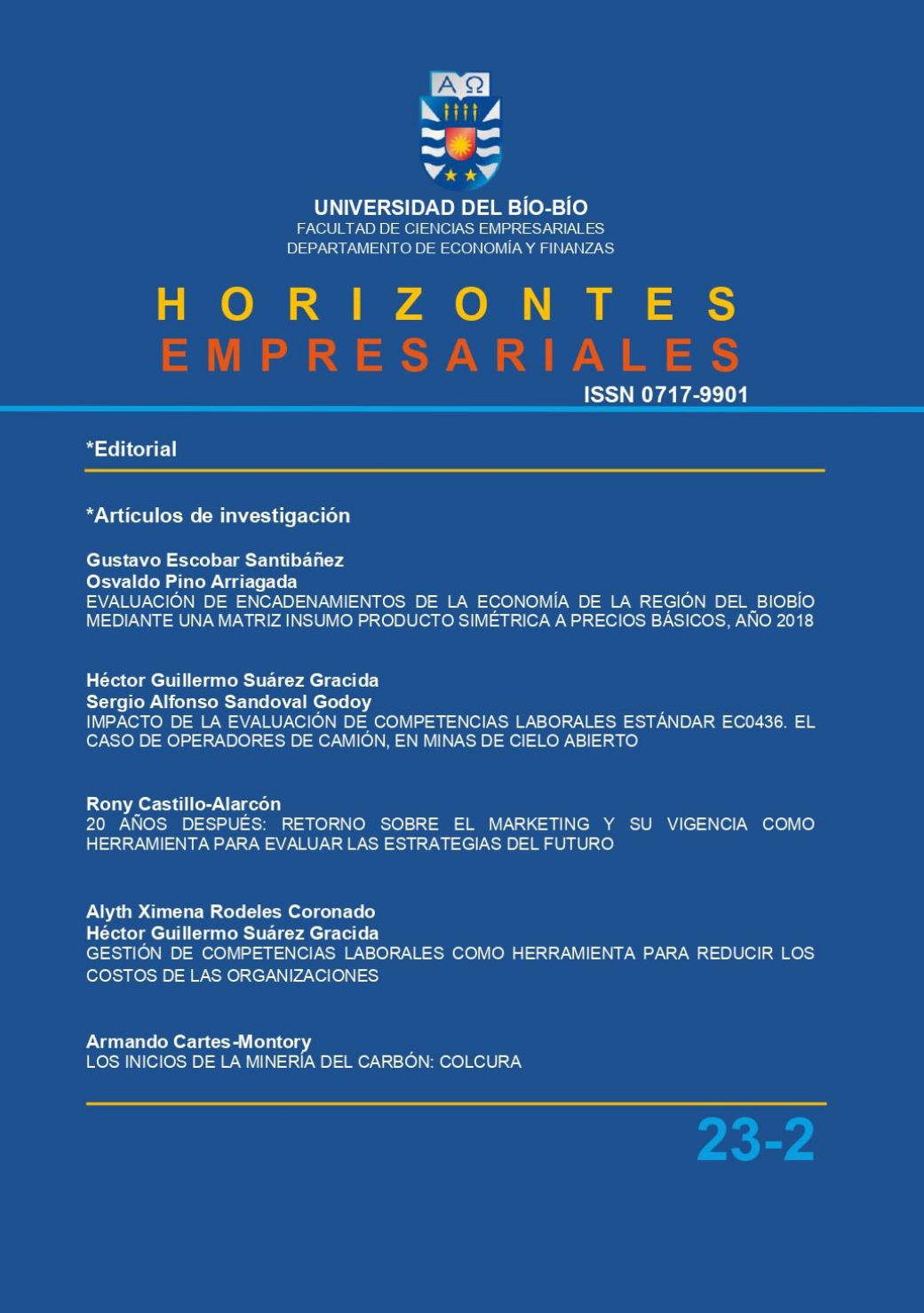20 años después: Retorno sobre el marketing y su vigencia como herramienta para evaluar las estrategias del futuro
DOI:
https://doi.org/10.22320/hem.v23i2.7004Palabras clave:
Retorno sobre el Marketing, Revisión de la literatura, Customer Life Value, Customer Equity, Marketing Science InstituteResumen
Contribuir con un análisis de las potencialidades del artículo seminal “Retorno sobre el Marketing: Usando el Patrimonio de Clientes para enfocar las Estrategias” en el aniversario N°20 de su publicación y brindar una guía sobre su refinamiento y gestión para medir el valor de vida de clientes y el desempeño de las firmas, en un entorno actual de alta competitividad y de creciente complejidad. A través de un ensayo basado en una revisión sistemática de la literatura con técnicas bibliométricas en Web of Science y Scopus, desde el 2004 a la fecha, en sus resultados se proponen oportunidades de mejora para los desafíos presentes de esta evaluación de desempeño desde el prisma del Marketing Science Institute para el 2024.
Citas
(*) Artículos en análisis de literatura asociados a discusión respecto a proyección de Retorno sobre el Marketing.
-2024 Research Priorities - Marketing Science Institute. (www.msi.org/research/2022-2024-research-priorities).
Aaker, David A. & Kevin Lane Keller (1990), “Consumer Evaluations of Brand Extensions,” Journal of Marketing, 54 (January), 27–41. DOI: https://doi.org/10.1177/002224299005400102
Anderson, James C. & James Narus (1990), “A Model of Distributor Firm and Manufacturer Firm Working Partnerships,” Journal of Marketing, 54 (January), 42–58. DOI: https://doi.org/10.1177/002224299005400103
Baumgarten, M., Büchner, A. G., Anand, S. S., Mulvenna, M. D., & Hughes, J. G. (2000). User-driven navigation pattern discovery from internet data. In Web Usage Analysis and User Profiling: International WEBKDD’99 Workshop San Diego, CA, USA, August 15, 1999 Revised Papers (pp. 74-91). Springer Berlin Heidelberg. DOI: https://doi.org/10.1007/3-540-44934-5_5
Benoit, D. F., Lessmann, S., & Verbeke, W. (2020). On realising the utopian potential of big data analytics for maximising return on marketing investments. Journal of Marketing Management, 36(3-4), 233-247.(*) DOI: https://doi.org/10.1080/0267257X.2020.1739446
Bhadra, A., & Rego, S. (2019). Relationship between Customer Equity and Customer Loyalty: A Study of Retail Outlets for Consumer Durables. Nmims Management Review, 36(4), 20-35.(*)
Chornous, G., Fareniuk, Y., Giedraitis, V. R., Ulvidienė, E., & Kharlamova, G. (2023). A data science-based marketing decision support system for brand management. Innovative marketing, 19(2), 38-50. (*) DOI: https://doi.org/10.21511/im.19(2).2023.04
Claro, D., Vieira, V. A., Agnihotri, R., & Serer, R. (2021). When value-and experience-related trade promotions influence retailers’ sales: the moderating role of retail format strategy and channel structure. European Journal of Marketing, 55(12), 3099-3128. (*) DOI: https://doi.org/10.1108/EJM-10-2020-0762
Cohen, M. D. (2004). Exploiting response models—optimizing cross-sell and up-sell opportunities in banking. Information Systems, 29(4), 327-341. DOI: https://doi.org/10.1016/j.is.2003.08.001
Gardner, Howard (2008), 5 Minds for the Future. Boston: Harvard Business School Press.
Grandhi, B., Patwa, N., & Saleem, K. (2021). Data-driven marketing for growth and profitability. Euromed Journal of Business, 16(4), 381-398. (*). DOI: https://doi.org/10.1108/EMJB-09-2018-0054
Gubela, R. M., Lessmann, S., & Jaroszewicz, S. (2020). Response transformation and profit decomposition for revenue uplift modeling. European Journal of Operational Research, 283(2), 647-661. (*) DOI: https://doi.org/10.1016/j.ejor.2019.11.030
Gubela, R. M., Lessmann, S., & Stöcker, B. (2024). Multiple treatment modeling for Target Marketing campaigns: A large-scale Benchmark Study. Information Systems Frontiers, 26(3), 875-898. (*) DOI: https://doi.org/10.1007/s10796-022-10283-4
Gummeson, Evert (1999), Total Relationship Marketing—Rethinking Marketing Management: From 4 P’s to 30 r’s. Oxford, UK: Butterworth-Heineman.
Gupta, Sunil, Donald R. Lehmann, & Jennifer A. Stuart (2001), “Valuing Customers,” Marketing Science Institute Report No. 01-119.
Hofstede, Geert, Gert Jan Hofstede & Michael Minkov. 1997. Cultures and Organizations. New York: mcgraw Hill.
Kushwaha, A. K., & Kar, A. K. (2024). Markbot–a language model-driven chatbot for interactive marketing in post-modern world. Information systems frontiers, 26(3), 857-874. (*) DOI: https://doi.org/10.1007/s10796-021-10184-y
Macinnis, D. J. (2011). A framework for conceptual contributions in marketing. Journal of Marketing, 75(4), 136-154. DOI: https://doi.org/10.1509/jmkg.75.4.136
Merigó, J. M., Mas-Tur, A., Roig-Tierno, N., & Ribeiro-Soriano, D. (2015). A bibliometric overview of the Journal of Business Research between 1973 and 2014. Journal of Business Research, 68(12), 2645-2653. DOI: https://doi.org/10.1016/j.jbusres.2015.04.006
Mishra, S., Ewing, M. T., & Cooper, H. B. (2022). Artificial intelligence focus and firm performance. Journal of the Academy of Marketing Science, 50(6), 1176-1197. (*) DOI: https://doi.org/10.1007/s11747-022-00876-5
Parasuraman, A. (1997), “Reflections on Gaining Competitive Advantage Through Customer Value,” Journal of the Academy of Marketing Science, 25 (2), 154–61. DOI: https://doi.org/10.1007/BF02894351
Rowley, J., & Slack, F. (2004). Conducting a literature review. Management research news, 27(6), 31-39. DOI: https://doi.org/10.1108/01409170410784185
Rust, R. T., Lemon, K. N., & Zeithaml, V. A. (2004). Return on marketing: Using customer equity to focus marketing strategy. Journal of marketing, 68(1), 109-127. DOI: https://doi.org/10.1509/jmkg.68.1.109.24030
Silva, S. C., Corbo, L., Vlačić, B., & Fernandes, M. (2023). Marketing accountability and marketing automation: evidence from Portugal. Euromed Journal of Business, 18(1), 145-164. (*) DOI: https://doi.org/10.1108/EMJB-11-2020-0117
Von Mutius, B., & Huchzermeier, A. (2021). Customer‐centric category selection for mobile and print promotions in loyalty reward programs. Naval Research Logistics (NRL), 68(6), 683-700.(*) DOI: https://doi.org/10.1002/nav.21934
Vriens, M., Brokaw, S., Rademaker, D., & Verhulst, R. (2019). The marketing research curriculum: Closing the practitioner–academic gaps. International Journal of Market Research, 61(5), 492-501. (*) DOI: https://doi.org/10.1177/1470785319843775
Zeithaml, Valarie A. (1988), “Consumer Perceptions of Price, Quality, and Value: A Means-End Model and Synthesis of Evidence,” Journal of Marketing, 52 (July), 2–22. DOI: https://doi.org/10.1177/002224298805200302




